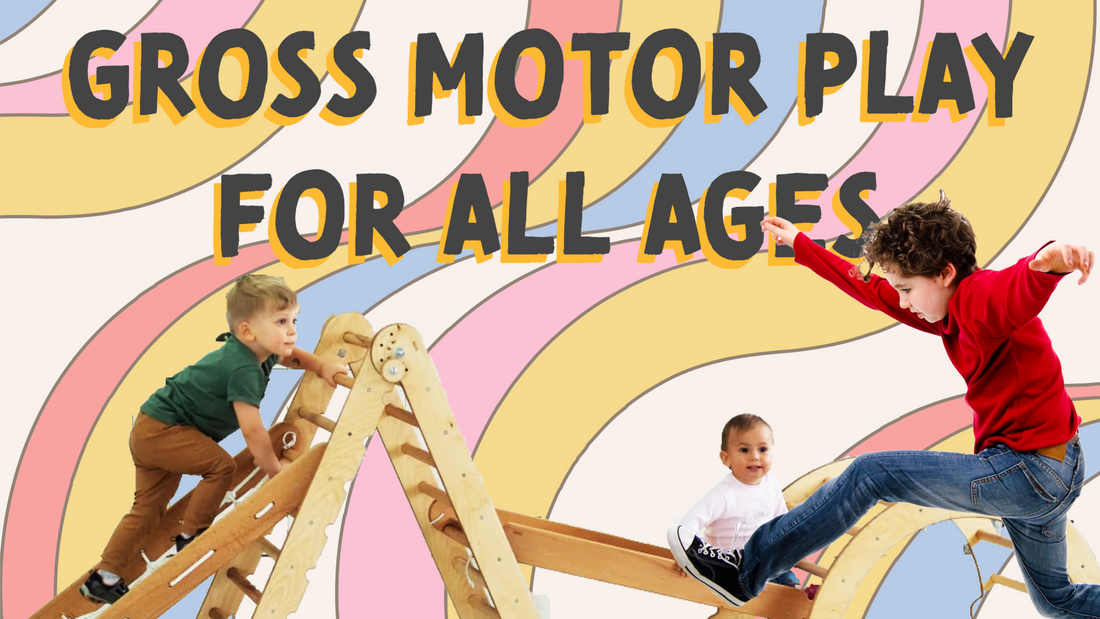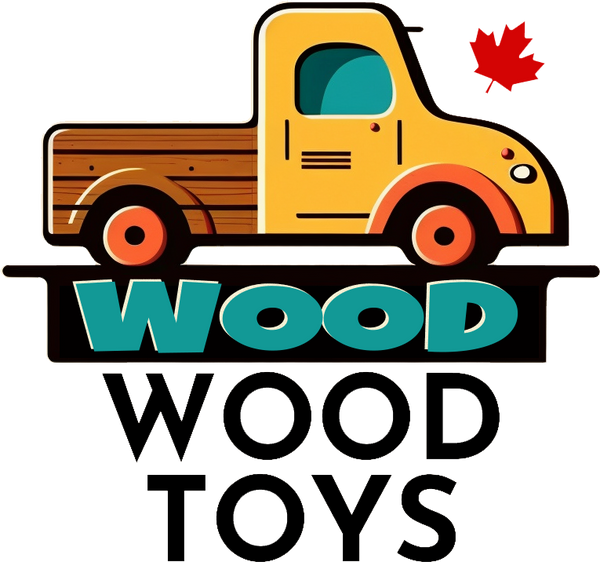
Comprendre la motricité globale : faits et avantages
Partager
La motricité globale est essentielle au développement global de l'enfant, car elle a un impact sur sa capacité à contrôler les mouvements de tout le corps à l'aide des bras, des jambes et du torse. Ces compétences commencent à se développer dès la naissance, lorsque les bébés fléchissent, tendent et agitent leurs bras et leurs jambes dans les airs. Le « jeu » est l'un des meilleurs moyens pour les enfants de développer et d'affiner ces compétences essentielles, et c'est quelque chose qui nous passionne chez Wood Wood Toys.
Les compétences motrices globales sont également appelées « compétences locomotrices ». Ces compétences englobent la coordination œil-main et œil-pied nécessaire à des activités comme attraper et donner des coups de pied, qui font également appel à la motricité fine. Le développement de ces compétences est essentiel pour que les enfants puissent accomplir des tâches quotidiennes.
Encourager le développement
La motricité globale est essentielle au développement physique et au bien-être général d'un enfant. Ces compétences impliquent l'utilisation de grands groupes musculaires et sont essentielles pour diverses activités dans différents environnements.
Il est essentiel d'encourager les enfants à pratiquer et à améliorer leur motricité fine et globale. Cependant, il est important de se rappeler que chaque enfant se développe à son propre rythme. Certains peuvent atteindre des étapes clés plus tôt, tandis que d'autres peuvent avoir besoin de plus de temps. L'essentiel est de fournir aux enfants des occasions de s'engager dans des activités qui favorisent le développement de ces compétences.
Cet article couvre :
- L’importance de la motricité globale
- Exemples de motricité globale
- Comment encourager le développement de la motricité globale
- Activités de motricité globale.
Les canapés de jeu, comme ceux de Go Coconut , offrent un moyen sûr et flexible d'explorer la motricité globale à l'intérieur.
Comment la motricité globale nous est-elle bénéfique ?
Même lorsque nous sommes assis, la motricité globale joue un rôle important dans le maintien d'une bonne posture. Ces compétences sont fondamentales pour les mouvements de base comme ramper, marcher et courir. Elles ne se limitent pas seulement au sport, mais sont également nécessaires pour les tâches quotidiennes comme s'habiller.
Comment la motricité globale soutient-elle la motricité fine ?
La motricité globale constitue la base de la motricité fine en améliorant la force musculaire, l'équilibre, l'endurance musculaire et la coordination. Développer ces compétences chez les enfants est essentiel car elles posent les bases de mouvements et d'activités plus complexes.
En favorisant la motricité globale des enfants, nous les aidons à construire une base solide pour les activités physiques, les résultats scolaires et la santé globale. Encourager les enfants à participer à des activités qui favorisent la motricité globale peut avoir des effets bénéfiques à long terme sur leur développement.
En développant ces compétences chez nos enfants, nous :
- Favoriser la santé durable du cerveau et du corps
- Développer la confiance et l'estime de soi
- Encourager la littératie physique
- Aider à la préparation à l'école
- Fournir un moyen sûr de libérer l'énergie
- Aidez-les à réguler la frustration et le stress
- Renforcer leur capacité à évaluer les risques
Examinons quelques exemples de motricité globale que les parents peuvent observer chez leurs enfants.
Les structures d'escalade, également connues sous le nom de triangle Pikler , sont l'un des moyens les plus populaires pour les bébés de développer l'équilibre, la coordination et la force motrice globale.
Étapes clés de la motricité globale du bébé
- 1 mois : Peut tenir la tête haute pendant de brefs intervalles après un mois.
- 3 mois : Maintient la tête et les épaules droites lorsqu'il est placé sur le ventre.
- 6 mois : se retourne sur le dos. Peut rester assis quelques secondes sans aide. Commence à saisir des objets dans ses deux mains.
- 9 mois : Tire son corps vers l’avant pour commencer à ramper.
- 12 mois : Reste debout pendant plusieurs minutes sans soutien.
- 15 mois : Marche sans aucune aide.
- 18 mois : Fonctionne.
- 20 mois : Monte et descend les escaliers.
Étapes clés de la motricité globale des tout-petits
- 2 ans : Il frappe dans un ballon.
- 2,5 ans : se tient sur la pointe des pieds et saute avec les deux pieds.
Étapes clés du développement moteur des enfants d’âge préscolaire
- 3 ans : Conduit un tricycle.
- 4 ans : Saute sur un pied. Lance une balle par-dessus le bras.
- 5 ans : sautille, sautille et peut conduire une trottinette.

Les « salles de jeux » pour bébés, dotées d'emplacements pour suspendre des éléments suspendus, donnent aux bébés la possibilité de pratiquer la préhension et les mouvements coordonnés tout en étant allongés sur le dos.
En tant que parent ou tuteur, vous pouvez commencer à favoriser le développement de la motricité globale dès le plus jeune âge. Voici comment introduire des exercices de développement précoce de manière amusante et sécuritaire.
Comment pouvez-vous aider à renforcer les muscles du cou de votre bébé ?
Bien que la tête d'un bébé ait besoin de soutien au cours des premiers mois, il commencera progressivement à renforcer ses muscles. Pour renforcer la confiance de votre bébé et renforcer les muscles de son cou, maintenez-le contre votre poitrine afin qu'il puisse regarder par-dessus votre épaule.
Quelle est l’importance du temps passé sur le ventre ?
Une autre façon d'encourager le développement de la motricité globale est de laisser les bébés passer beaucoup de temps sur le ventre sous surveillance lorsqu'ils sont éveillés. Posez un tapis ou une couverture confortable sur le sol et placez votre bébé sur le ventre. Déplacez-vous dans la pièce et motivez votre enfant à lever la tête et à renforcer les muscles de son cou pour vous voir.
En intégrant ces activités simples à votre routine quotidienne, vous pouvez aider votre bébé à développer la force et la coordination nécessaires à des étapes importantes comme s'asseoir, ramper et éventuellement marcher. N'oubliez pas de toujours offrir un environnement sûr et favorable à votre tout-petit pour qu'il puisse explorer et grandir.
Entre 6 et 12 mois, les capacités sensorielles de votre bébé commencent à se développer, jetant les bases de sa croissance et de son apprentissage futurs. Au cours de cette période cruciale, la participation à des activités ludiques peut considérablement stimuler le développement de sa motricité globale. Si votre enfant montre de la motivation pour atteindre des objets et est encouragé à renforcer les muscles de ses jambes, l'introduction d'une salle de jeux pour bébé peut être un ajout utile à cet âge.
À mesure que votre enfant grandit, vous pouvez lui proposer de plus en plus d'activités pour développer sa motricité globale par le jeu. Voici une liste d'activités qui peuvent l'aider à améliorer sa motricité globale :
- Peindre et créer de larges traits : Peindre et créer de larges traits avec un pinceau permet non seulement de faire preuve de créativité, mais aide également à promouvoir la motricité globale et la coordination œil-main.
- Jeu général : Des activités telles que courir, sauter, sauter et bondir sont d’excellentes façons de participer à un jeu général tout en améliorant la motricité globale.
- Faire rebondir, rouler, lancer, donner des coups de pied et frapper un ballon : Participer à des activités impliquant un ballon, comme faire rebondir, rouler, lancer, donner des coups de pied et frapper, peut aider à développer la motricité globale.
- Équilibre : pratiquer l’équilibre sur la pointe des pieds, sur une bûche ou sur une corde raide tendue sur le sol peut améliorer l’équilibre et la coordination.
- Escalade : L’escalade dans des environnements sûrs, comme des terrains de jeux sous la surveillance d’un adulte, est un excellent moyen de renforcer la motricité globale.
- Garder un ballon en l’air : Jouer avec un ballon et essayer de le maintenir en l’air en le frappant avec la tête ou les mains peut améliorer la coordination et la motricité.
- Barboter dans l'eau : barboter dans l'eau permet non seulement de vivre une expérience sensorielle amusante, mais aussi de renforcer les muscles des jambes. Surveillez toujours les jeux d'eau pour plus de sécurité.
- Danser, marcher et sauter au rythme de la musique : Bouger au rythme de la musique en dansant, en marchant et en sautant peut améliorer la coordination, l’équilibre et la motricité globale.
- Apprendre à rouler sur des roues : Apprendre à rouler sur des roues, comme un tricycle ou un scooter, peut aider à développer l’équilibre et la coordination.
- Utiliser le poids du corps pour se balancer : Utiliser le poids du corps pour se balancer et gagner de l’élan sur les swings peut aider à améliorer la motricité globale.
- Jouer à la marelle : Jouer à la marelle est une façon amusante et engageante d’améliorer l’équilibre, la coordination et la motricité globale.
Le jeu de motricité globale rencontre le jeu de simulation avec des cuisines de jeu extérieures comme celle-ci de Noble Wooden Toys .



